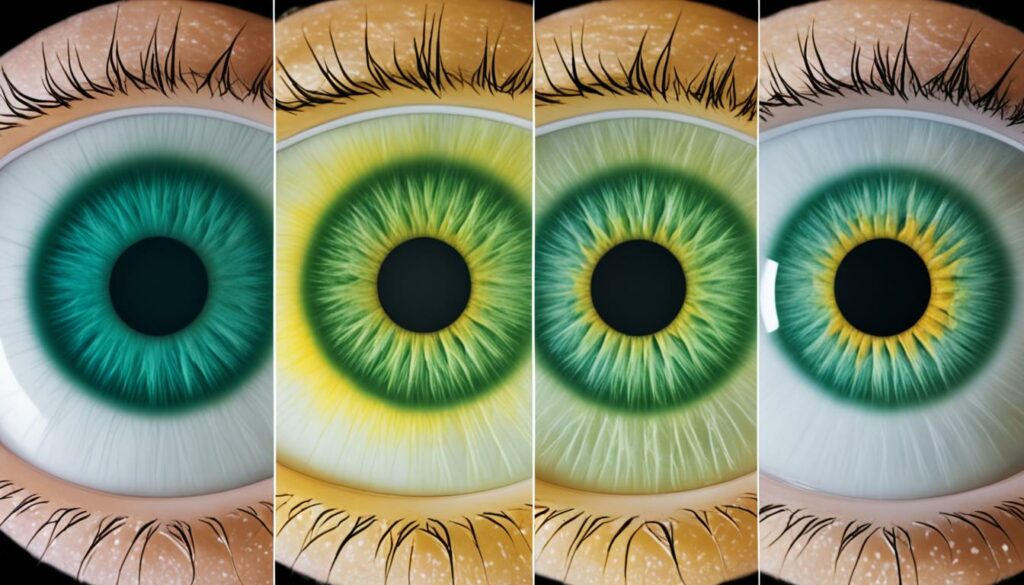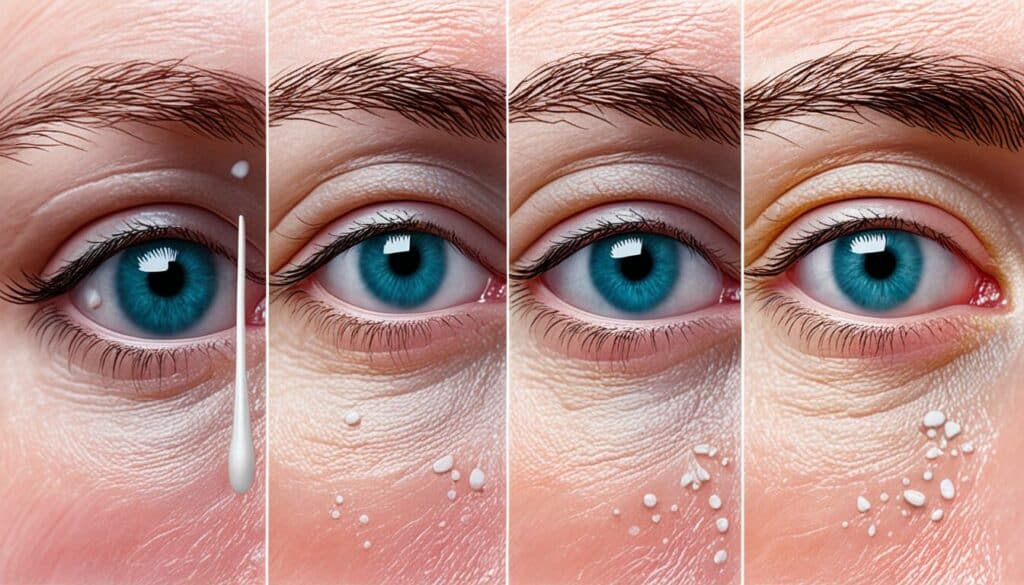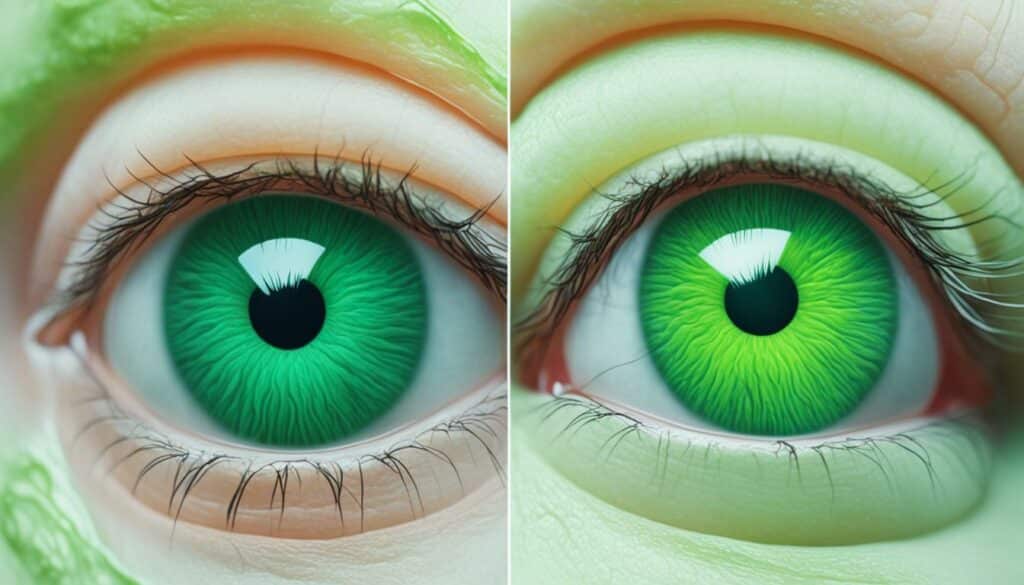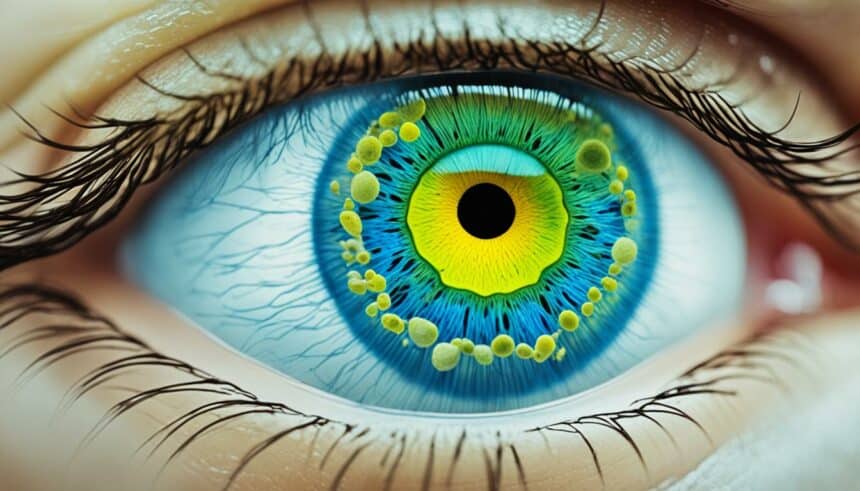Welcome to our comprehensive guide on understanding the types of eye mucus and what they can reveal about your eye health. Eye mucus, also known as eye discharge or eye gunk, is a natural part of your eye’s defense mechanism. By knowing the different types of eye discharge, crust, boogers, secretions, and goop, you can identify any potential issues and take appropriate action for optimal eye care.
Key Takeaways:
- Eye mucus, also known as eye discharge or eye gunk, is a natural part of your eye’s defense mechanism.
- Understanding the various types of eye mucus can help you identify potential eye health issues.
- Watery eye discharge is usually a result of excessive tear production and can be caused by irritation, allergies, or conjunctivitis.
- Thick, sticky eye discharge, also known as eye crust or eye boogers, is often associated with bacterial or viral infections such as conjunctivitis.
- Stringy or gelatinous eye mucus indicates an issue with the meibomian glands and can be linked to conditions like dry eye syndrome or meibomian gland dysfunction.
What is Eye Mucus?
Eye mucus, also known as eye discharge or eye gunk, refers to the substance that can accumulate around or inside the eyes. It is a natural part of your eye’s defense mechanism, helping to keep the eyes moisturized, lubricated, and free from harmful particles. However, different types of eye mucus can indicate different underlying conditions.
**Eye mucus** is essential for the overall health and function of your eyes. This sticky substance serves as a protective barrier against dust, debris, and infectious agents. Throughout the day, your eyes constantly produce **eye mucus** to trap and remove any potential irritants, maintaining their clear and comfortable state.
“Eye mucus plays a vital role in the maintenance of ocular health by ensuring the eyes remain moist and lubricated. Each type of **eye mucus** indicates specific conditions or situations that your eyes may be experiencing.”
– Dr. Olivia Johnson, Ophthalmologist
The consistency, color, and quantity of **eye mucus** can vary depending on several factors, including your overall health, environmental influences, and underlying eye conditions. By closely monitoring the characteristics of **eye mucus**, you can gain valuable insights into your eye health and take appropriate actions, such as seeking medical advice or making adjustments to your eye care routine.
Throughout this comprehensive guide, we will delve deeper into the various types of **eye mucus** and their implications for eye health. By understanding the different types and their significance, you can become better equipped to identify any abnormalities or issues and address them proactively.
Understanding Eye Mucus Consistency and Color
The consistency and color of **eye mucus** can provide valuable clues about your eye health. Here are some common characteristics you may encounter:
| Consistency | Color | Potential Causes |
|---|---|---|
| Watery and clear | Transparent | Allergies, irritation, excessive tear production |
| Thick and sticky | Yellow or green | Bacterial or viral infections, conjunctivitis |
| Stringy or gelatinous | Transparent or cloudy | Dry eye syndrome, meibomian gland dysfunction |
| Blood-tinged | Red or brown | Infections, injuries, underlying medical conditions |
Types of Eye Mucus
When it comes to eye mucus, there are several different types that you may encounter. Each type has its own characteristics, including consistency, color, and potential causes. By familiarizing yourself with these different types, you can gain valuable insights into your eye health and take appropriate action if needed.
- Watery Eye Discharge: This type of eye mucus is clear and liquid-like. It is often a result of excessive tear production and can be caused by irritations, allergies, or conjunctivitis.
- Thick, Sticky Eye Discharge: Also known as eye crust or eye boogers, this type of mucus is usually yellow or green in color. It is commonly associated with bacterial or viral infections, such as conjunctivitis or pink eye.
- Stringy or Gelatinous Eye Mucus: This type of eye mucus indicates an issue with the meibomian glands, which produce the oily layer of tears. It may be a sign of conditions like dry eye syndrome or meibomian gland dysfunction.
- Blood-Tinged Eye Discharge: In some cases, eye mucus may appear to have a reddish or brownish tint, indicating the presence of blood. Blood-tinged eye discharge can be caused by infections, injuries, or underlying medical conditions.
Recognizing the type of eye mucus you have can provide valuable insights into your eye health and help you determine if further medical evaluation is necessary. If you experience persistent or concerning symptoms, it is always best to consult with an eye care professional for a thorough examination and appropriate guidance.
Next, we will delve into more detail about watery eye discharge and its potential causes. Stay tuned!
Watery Eye Discharge
Watery eye discharge, also known as serous discharge, is a common type of eye mucus that appears clear and liquid-like. This discharge is usually a result of excessive tear production, which can be triggered by various factors such as irritation, allergies, or conjunctivitis.
When the eyes encounter an irritant, such as dust, smoke, or allergens, they may produce an increased amount of tears to wash away the foreign substance. This can lead to watery eye discharge as the excess tears drain from the eyes.
Similarly, allergies can cause the eyes to become watery and produce more tears than usual. Seasonal allergies, also known as hay fever, can trigger a range of symptoms, including watery eyes. Allergens like pollen, mold spores, or pet dander can irritate the eyes and lead to watery eye discharge.
In some cases, watery eye discharge may be a symptom of conjunctivitis, commonly referred to as pink eye. Pink eye can be caused by viruses, bacteria, or allergies, and typically involves symptoms such as redness, itching, and excessive tearing.
If you are experiencing watery eye discharge, it is essential to determine the underlying cause. Identifying and addressing the root cause can help alleviate any discomfort and prevent recurring episodes. If the discharge persists or is accompanied by other concerning symptoms, it is advisable to consult an eye care professional for a proper diagnosis and appropriate treatment.

| Causes of Watery Eye Discharge | Symptoms |
|---|---|
| Irritants such as dust, smoke, or allergens | Excessive tear production |
| Allergies (e.g., hay fever) | Redness and itching |
| Conjunctivitis (pink eye) | Excessive tearing, redness, itching, and inflammation |
Knowing the potential causes of watery eye discharge can assist in determining the appropriate course of action. If allergies are the culprit, avoiding known triggers, using antihistamine eye drops, or implementing allergy management strategies may help reduce symptoms. On the other hand, if conjunctivitis is suspected, it may be necessary to consult with a healthcare professional for a proper diagnosis and to determine the appropriate treatment options.
Thick, Sticky Eye Discharge
Thick and sticky eye discharge, often referred to as eye crust or eye boogers, can be yellow or green in color. This type of discharge is commonly associated with bacterial or viral infections, such as conjunctivitis or pink eye.
When you have thick, sticky eye discharge, it is important to recognize its characteristics, as this can prompt you to seek appropriate medical treatment.
Cleaning the area around your eyes gently with warm water can help remove the crust and alleviate discomfort. However, if the discharge persists or is accompanied by other symptoms like redness, pain, or vision changes, it is recommended to consult an eye care professional for a proper diagnosis and treatment plan.

Stringy or Gelatinous Eye Mucus
Stringy or gelatinous eye mucus is a type of eye discharge that often indicates an issue with the meibomian glands. These glands are responsible for producing the oily layer of tears that prevents evaporation and keeps the eyes lubricated. When these glands dysfunction, it can lead to the formation of stringy or gelatinous mucus.
This type of eye mucus is commonly associated with conditions like dry eye syndrome or meibomian gland dysfunction. Dry eye syndrome occurs when the eyes do not produce enough tears or when the tears evaporate too quickly. Meibomian gland dysfunction, on the other hand, is characterized by blockages or abnormalities in the meibomian glands.
Stringy or gelatinous eye mucus may appear as strands or clumps that adhere to the eyelashes or the corners of the eyes. It can cause discomfort and contribute to blurry vision. If you notice this type of eye mucus, it is important to consult with an eye care professional to determine the underlying cause and explore appropriate treatment options.

Treatment Options for Stringy or Gelatinous Eye Mucus
The treatment for stringy or gelatinous eye mucus depends on the underlying cause. In some cases, simple hygiene practices, such as regular eyelid cleansing and warm compresses, may help clear the mucus and alleviate symptoms. Lubricating eye drops or artificial tears can also provide relief by lubricating the eyes and reducing dryness.
If the meibomian glands are blocked or dysfunctional, your eye care professional may recommend treatments to improve gland function and relieve symptoms. These treatments can include warm compresses, eyelid massages, or the use of specialized devices to unclog the glands. In more severe cases, medications or surgical interventions may be necessary.
It is important to follow your eye care professional’s recommendations and maintain good eye hygiene to manage stringy or gelatinous eye mucus effectively. Regular follow-up appointments may be necessary to monitor your eye health and adjust the treatment plan as needed.
Blood-Tinged Eye Discharge
In some cases, eye mucus may appear to have a reddish or brownish tint, indicating the presence of blood. Blood-tinged eye discharge can be caused by various factors, including infections, injuries, or underlying medical conditions. Recognizing this type of discharge is essential for determining the need for immediate medical attention.
When you notice blood-tinged eye discharge, it’s crucial not to ignore it. While it may be concerning, it’s essential to understand that it could indicate a more severe underlying issue. Consulting with an eye care professional can help identify the cause of the blood in the eye discharge and determine the most appropriate course of action for your eye health.
Causes of Blood-Tinged Eye Discharge
The presence of blood in eye discharge can stem from various causes, including:
- Infections such as conjunctivitis or blepharitis
- Eye injuries or trauma
- Corneal ulcers
- Foreign objects in the eye
- Conditions like dry eye syndrome or allergies
These causes can lead to blood vessels in the eye becoming damaged or irritated, resulting in blood mixing with the eye mucus.
When to Seek Medical Attention
If you experience blood-tinged eye discharge, it’s essential to consult with an eye care professional promptly. They can evaluate your condition, diagnose the underlying cause, and recommend the appropriate treatment. Delaying or ignoring symptoms may lead to further complications or vision problems.
In addition to blood-tinged eye discharge, you may also experience other accompanying symptoms, such as:
- Eye pain or discomfort
- Increased sensitivity to light
- Blurry or distorted vision
- Redness or swelling around the eye
“If you notice blood in your eye discharge, don’t hesitate to seek medical attention. Early intervention can help prevent any potential complications and ensure optimal eye health.”
Remember, your eye health is precious, and it’s always better to be safe than sorry when it comes to any changes in your eye discharge, especially if blood is present.
| Possible Causes of Blood-Tinged Eye Discharge | Symptoms | Treatment |
|---|---|---|
| Infections such as conjunctivitis or blepharitis | Redness, swelling, irritation | Antibiotics, eye drops |
| Eye injuries or trauma | Pain, sensitivity to light, blurred vision | Emergency care, eye patching, medication |
| Corneal ulcers | Eye pain, blurriness, redness | Antibiotics, eye ointments |
| Foreign objects in the eye | Tearing, eye redness, discomfort | Eye irrigation, removal of the foreign object |
| Conditions like dry eye syndrome or allergies | Dryness, itching, redness | Lubricating eye drops, allergy medications |
Conclusion
In conclusion, understanding the various types of eye mucus is crucial for maintaining optimal eye health. By familiarizing yourself with the different forms of eye discharge, crust, and secretions, you can better assess the condition of your eyes and take appropriate action when needed.
Regular eye hygiene practices, such as gently cleaning the eyes with a warm, damp cloth, can help prevent the buildup of excessive mucus and reduce the risk of eye infections. Additionally, seeking prompt medical attention for persistent or unusual eye mucus can aid in the early diagnosis and treatment of underlying eye conditions.
Remember, your eyes are precious organs that deserve proper care and attention. By staying informed about the types of eye mucus and actively maintaining good eye hygiene, you can support your overall well-being and ensure clear vision for years to come.








